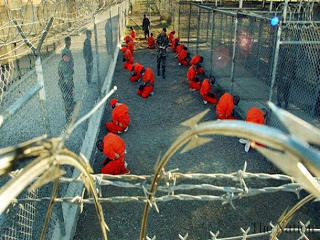Twenty years ago, on January 11, 2002, the prison at Guantánamo Bay (GITMO) admitted its first round of post-9/11 terrorist suspects. Two recent films, The Mauritanian (2021) and The Forever Prisoner (2021), chart parts of the ugly history of the facility, during which acts of torture were rebranded by officials as “enhanced interrogation techniques” (EIT) and inflicted on at least 119 of the 780 men held at GITMO over the course of the Global War on Terror. The story of Mohamedou Ould Slahi, who was cleared for release in 2010 but remained incarcerated for another seven years as the Obama administration appealed the decision, is relayed in director Kevin Macdonald’s film The Mauritanian. The story of Abu Zubaydah, who remains incarcerated still today, is covered by Alex Gibney’s film The Forever Prisoner.
Many other men were abused in prisons such as Abu Ghraib in Iraq and Bagram in Afghanistan, in addition to an array of “black sites” erected around the world in collaboration with “torture-friendly” governments. The CIA’s EIT program was commissioned and approved at the highest levels of the U.S. government, and deemed legal by Deputy Assistant Attorney General John Yoo. The practices included waterboarding (which mimics drowning), slamming detainees’ heads against the wall, rectal feeding, confining naked suspects in small boxes along with insects, depriving them of sleep for days on end, and forcing them to endure extremely cold temperatures while naked. Some of the victimized men died, and while a number of deaths were characterized by the powers that be as suicides, at least one prisoner was acknowledged to have died of hypothermia as a direct result of the conditions he was forced to endure.
The nightmarish series of abuses to which these men were subjected were claimed by the architects and orchestrators of the EIT program to be supported by “the science” and sure to save American lives. At least twenty-six of the victims of torture held in GITMO were later determined to have been captured in error in what were most charitably interpreted as overzealous efforts to thwart the next terrorist attack. Bounty hunter greed and/or penury appears also to have played a significant role in the erroneous capture of thousands of innocent men throughout the War on Terror.
A thorough investigation of classified CIA documents eventually culminated in the 2014 release of the “Report of the Senate Select Committee on Intelligence Committee Study of the Central Intelligence Agency’s Detention and Interrogation Program.” This 712-page document, which has come to be referred to colloquially as “The Torture Report,” includes a 500+ page executive summary of the thousands of pages of the original report instigated by committee chair Senator Diane Feinstein and prepared over a period of several years by her staffer Daniel Jones, among others. The investigation was undertaken in response to the revelation that the CIA had destroyed films of some of the detainees being victimized. The story of how The Torture Report was commissioned and eventually released is relayed in the 2019 film The Report (directed by Scott Z. Burns), which offers shocking insights into the lengths to which the CIA—including the director at the time of the report’s release, John Brennan—were willing to go in order to absolve themselves from allegations of wrongdoing.
Faced with the findings of the report, some of those involved, including former Vice President Dick Cheney and former CIA Deputy Director for Operations José Rodriguez, continued to deny that “enhanced interrogation techniques” were morally repugnant forms of torture. Others employed by the U.S. government during that period, including John Brennan, claimed that they had expressed moral reservations about the program, although there is no written evidence to that effect, and the director of the CIA at the time, George Tenet, has publicly denied that he was ever approached with such objections. The EIT program proved in any case to be tactically nugatory, at best.
According to the report’s authors, none of the ghastly procedures deployed resulted in actionable intelligence used to thwart terrorist attacks. Some of the men were entirely innocent and so obviously had no information to share; others told interrogators only information which had already been obtained from other sources or which had already gone stale; and some of the men simply made up stories so as to call a halt to the torture. Most notoriously, the false claim that Saddam Hussein was in cahoots with Al Qaeda was obtained through torture and used to rationalize the misbegotten 2003 war on Iraq.
In response to the Senate committee’s report, President Obama, to his credit, publicly admitted that “We tortured some folks,” and issued Executive Order 133491, “Ensuring Lawful Interrogations.” The order references the Geneva Conventions and explicitly prohibits the barbaric activities perpetrated by U.S. government employees and contractors under the guise of “enhanced interrogation techniques.” Notwithstanding Obama’s rhetorical efforts to restore the image of the United States as a beacon of human rights, the president never delivered on one of his primary campaign promises, to close the prison at Guantánamo Bay. He also declined to prosecute any of the torturers. Obama did stop sending new prisoners to the facility, and some of the remaining prisoners were released and sent to other countries for processing and rehabilitation.
The primary obstacle to Obama’s closure of GITMO was claimed by his apologists to be the political opposition he encountered to the prospect of suspects’ standing trial in the United States, which was thought by some to risk the increased incidence of terrorist attacks in the homeland. Concerns were also raised that some of the prisoners may have been made more dangerous by the torture to which they were subjected. Indeed, it was thought by some that even men who were not previously connected to terrorist groups, having been captured and imprisoned on the basis of faulty intelligence, may have been radicalized by the dramatic proof of the evil nature of the U.S. empire which they themselves had personally witnessed.
The Guardian recently reported that some of the men removed from GITMO and relocated to other countries have been stuck in legal limbo for years, unable to return to normal life because they have not been cleared for release by the governments of those countries. Others have found themselves unemployable and therefore unable to reassimilate into civil society. But they are still alive, which cannot be said of the many suspects pegged during the eight years of Obama’s presidency and labeled “Enemy Killed in Action” (EKIA) after having been dispatched by missiles launched from drones on the basis of purely circumstantial evidence of possible future complicity in possible future terror plots. We have Daniel Hale, the drone program whistleblower now serving a federal prison sentence, to thank for sharing documents revealing that suspects were effectively defined by the Obama administration as guilty until proven innocent before being summarily executed.
A number of politicians in addition to Obama, including the instigator of the Torture Report, Senator Dianne Feinstein, and Senator John McCain, who was a prisoner of war (POW) in Vietnam, spoke out against torture, agreeing with Obama that “That’s not who we are.” In addition to straightforward moral concerns about abusing human beings, some politicians and military officers aired concerns that such practices could also endanger U.S. troops, who when taken prisoner might be subjected to similarly cruel techniques.
Shockingly, however, some of the most vociferous denouncers of torture, including Senators Feinstein and McCain, continued enthusiastically to support the far more ghastly practice of summary execution without trial of suspects, often unnamed, on the basis of purely circumstantial evidence, even when the targets were neither bearing arms nor located in war zones. The Obama administration itself reported in 2016 that they had ended the lives of between 2,372 and 2,581 of such men “outside areas of active hostilities,” in countries such as Yemen and Pakistan (not the active war zones of Afghanistan, Iraq, or Syria) where there were no uniformed U.S. soldiers on the ground to protect.
Having spoken out about the crimes committed by the Bush administration, Obama opted not to take as prisoners the suspects identified by his own administration using the very same forms of evidence which had served as the basis for capturing and imprisoning thousands of men during the first eight years of the War on Terror. It is therefore essential to observe here that 732 of the 780 men incarcerated at GITMO were eventually released without charges. Because the types of circumstantial evidence being used to peg suspects did not change under Obama, and continued to include intelligence obtained from bribed informants (human intelligence or HUMINT), and cellphone SIM card data and drone video footage (signals intelligence, or SIGINT), we have grounds for believing that many of the thousands of men executed rather than captured during Obama’s presidency, were, too, innocent.
President Obama had a choice to make in the light of the revelation that longterm detention and torture did not yield actionable intelligence. But rather than capture suspected militants and treat them humanely, detaining them in circumstances conducive to proper judicial processing, respecting their rights and acknowledging the very real possibility that they might in fact be innocent, his administration instead defined them as guilty until proven innocent and executed them using lethal drones.
Mentored by his drone-killing czar, John Brennan, Obama became known as the “drone warrior president,” who revved up a veritable “killing machine” to eliminate nearly all of the terror suspects identified as such during his eight-year term as president. Obama and Brennan (promoted to director of the CIA in 2013), opted to use lethal drones to execute suspects on hit lists generated by a vast network of government employees and private contractors who collected and analyzed HUMINT and SIGINT. These hit lists were reviewed by the president himself during what were termed “Terror Tuesday” meetings in which nominees for execution were evaluated on the basis of flash card presentations.
When the Obama administration located and executed Al Qaeda leader Osama bin Laden in 2011, the president was praised by many U.S. citizens. Later that year, he proceeded to act on the political capital he had garnered to take the drone program to a qualitatively new level, executing even U.S. citizens without indictment or trial. He authorized the killing of not only Anwar al-Awlaki, a formerly moderate Muslim cleric arguably radicalized by the War on Terror itself, and Samir Khan, a propagandist, but also, two weeks later, al-Awlaki’s sixteen-year-old son, Abdulrahman, along with a group of his teenage friends.
Obama himself never deigned to explain why Abdulrahman al-Awlaki, a teenager not suspected by anyone of terrorism, was eliminated, but it seems unlikely to have been a “coincidental” targeting error. In fact, Robert Gibbs, Obama’s press secretary at the time, offered the following garbled answer when asked about the U.S. government’s killing of Abdulrahman al-Awlaki:
I would suggest that you should have a far more responsible father if they are truly concerned about the well being of their children. I don’t think becoming an al Qaeda jihadist terrorist is the best way to go about doing your business.
The gravity of this normalization of summary execution of suspects and their associates (including family members) appears to have escaped altogether those who throughout the Trump presidency waxed nostalgically about the “good old days” when mild-mannered, anti-torture Obama was president. On the campaign trail in 2016, Trump vowed not only not to close GITMO, but also that he would fill up the facility with “bad dudes.” In reality, once president, Trump simply followed Obama’s lead, putting his newly appointed defense secretary, James “Mad Dog” Mattis on a very long leash and essentially allowing the killing machine—not only the drone program but also special operations forces—to eliminate anyone anywhere suspected of connections to “bad dudes.” Trump, like Obama, killed one of the children of Anwar al-Awlaki. In Trump’s case the victim was an eight-year-old girl, Nawar al-Awlaki, who was destroyed by U.S. special forces during a raid in Yemen, where both her father and her brother had been killed by drones.
Predictably enough, the norms governing state homicide were loosened yet again when President Trump, in his usual swagger-filled attempt to outdo his predecessor, openly vaunted his assassination of Qassim Soleimani, an Iranian general who was located in Iraq at the time. Before the War on Terror, assassination was widely regarded, even by U.S. officials, as illegal. President Bush may bear primary responsibility for the torture program, but we have President Obama to thank for having normalized the premeditated, intentional execution of persons believed by their killers to be dangerous, even when they are unarmed and located outside areas of active hostilities. This sleight of hand was accomplished through putting the CIA in charge of the drone program, ironically the very organization which had presided over the practices denounced in The Torture Report.
In the case of summary execution by drone of suspects, the CIA operated for years under its usual cloak of secrecy, allowing it to evade congressional oversight. As many critics of the drone program have observed (myself included), the decision to enlist the CIA to run the killing machine outside areas of active hostility was in all likelihood an effort to evade accusations of war crimes, to which the military itself would have been subject. In abject violation of the Geneva Conventions, the targets of drone strikes are not provided with the opportunity to surrender or lay down their arms, nor to defend themselves against allegations based on faulty intelligence. In other words, this slick rebranding of assassination as “targeted killing” also violates the Universal Declaration of Human Rights, according to which suspects are to be considered innocent until proven guilty. Instead, the “principle” governing the premeditated, intentional execution of specific persons at the caprice of the killers is tantamount to “Everything is permitted.”
Leaders rarely cede power unless forced to do so, and U.S. military leaders have long aimed to maximize both efficiency and lethality, so it should come as no surprise that President Joe Biden has taken up the drone-killing mantel to continue fecklessly on with the same policies vaunted by Obama as “smart war.” One horrifying example of the general laxity of standards in the use of lethal force by the U.S. government, regardless of who is in charge, was the incineration on August 29, 2021, of ten civilians in Kabul, Afghanistan, on the basis of intelligence according to which people who drive white Toyota Corollas and move stuff around town might be planning to bomb the airport. A Pentagon investigation into the case concluded that no wrongdoing had been committed, as the perpetrators had abided by standard protocols and followed their rules of engagement. As a direct result of the manner in which the drone program has evolved through four presidencies, the impunity long enjoyed by the CIA for what once were plausibly deniable acts of lawless killing has in this way been transferred to the military as well.
Torture is inhumane, barbaric, and immoral. It harms the victims both physically and psychologically, and it degrades the perpetrators, who are corrupted by their atrocious treatment of fellow human beings. We should accordingly welcome films such as The Mauritanian, The Forever Prisoner, and The Report, which aim to illuminate some of the many crimes committed in our names and using our tax dollars. Let us not, however, be distracted by the heartfelt denunciations of torture by some government officials from the even more egregious practices which some of them continue to champion.
As objectionable as torture may be, its perpetrators can still be conceptualized as having chosen misguided means to the acquisition of what they believed would be actionable intelligence needed to thwart imminent terrorist attacks. In contrast, the summary execution of unarmed suspects located outside areas of active hostilities, and identified as such on the basis of purely circumstantial evidence, serves no tactical or strategic aim whatsoever. It is evil, pure and simple: the intentional, premeditated annihilation of human beings denied all human rights, from the right to surrender, to the right to defend themselves against false claims that they have committed crimes.
Substituting drone killing of suspects for longterm detention and torture may seem superficially less objectionable to the untutored populace, but as is so often the case, appearance diverges starkly from moral reality. Through linguistic neologism and rebranding, conjoined with the development of technologies which have made it possible to kill anyone anywhere, through the push of a button from thousands of miles away, the atrocious practice of torture has been supplanted by the intrinsically evil and tyrannical practice of summary execution without indictment or trial. Is this who we are?
















